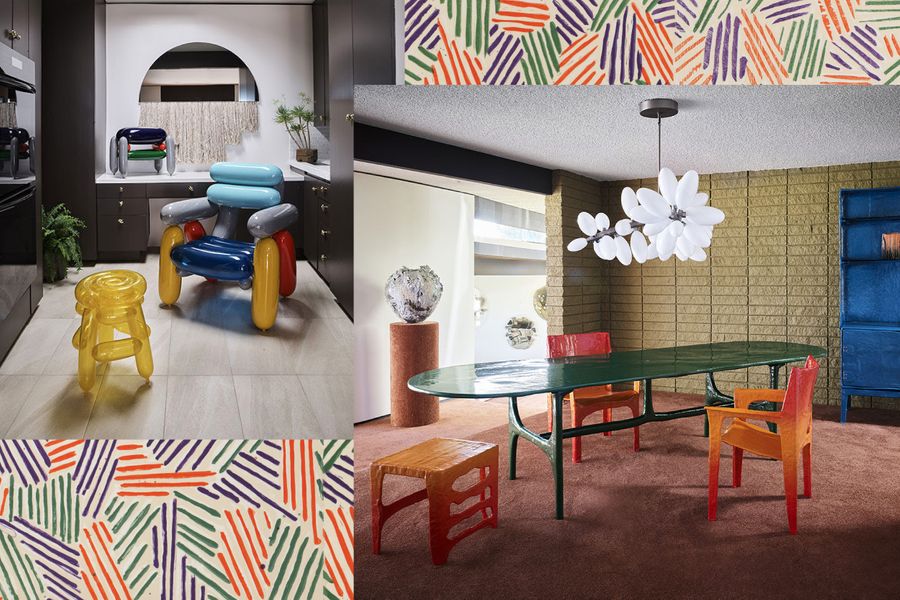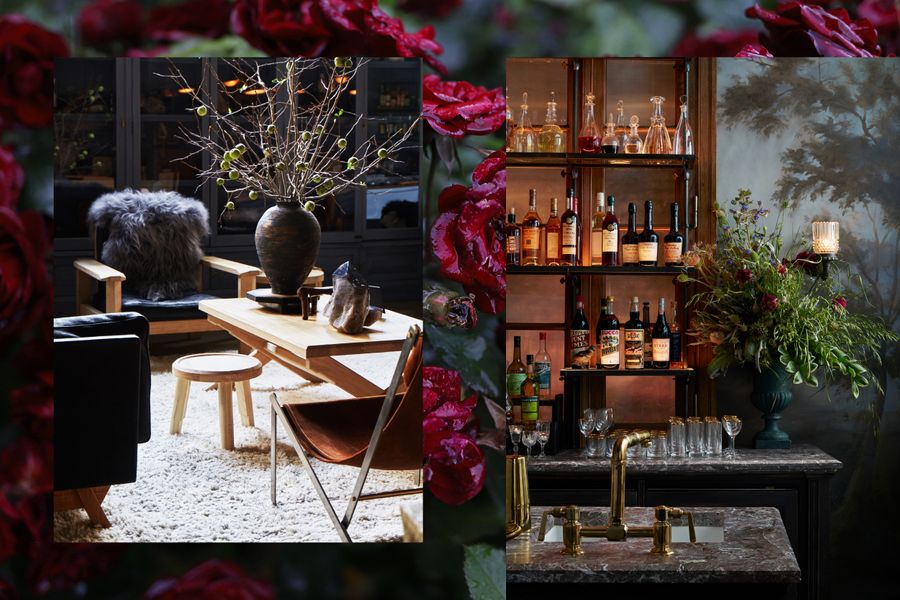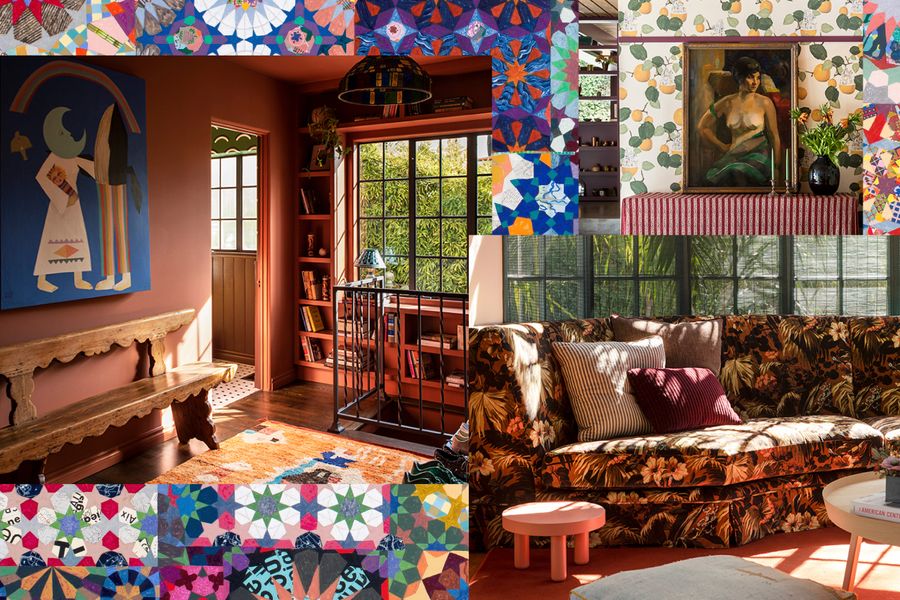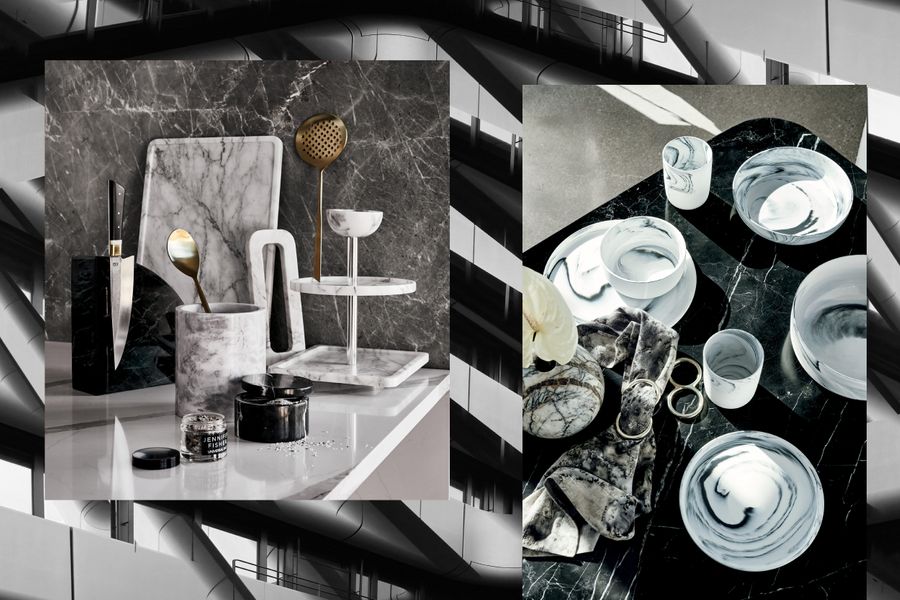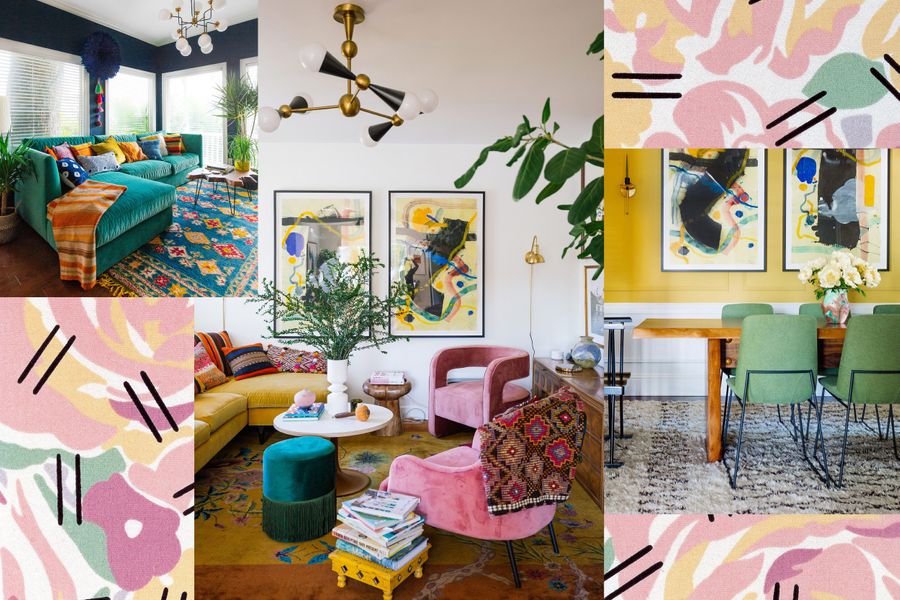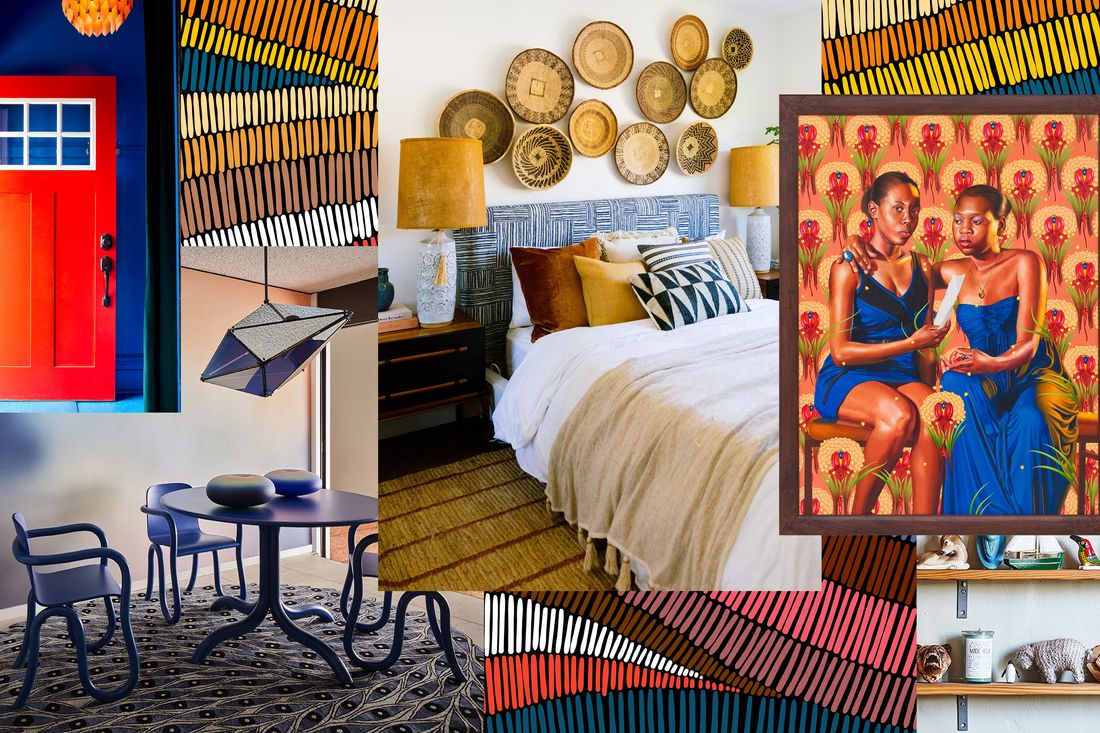
This story was originally published by Curbed before it joined New York Magazine. You can visit the Curbed archive at archive.curbed.com to read all stories published before October 2020.
Here’s the thing with patterns: Once you see them, you can’t stop seeing them. For a while, Jenelle Porter, an independent art curator, couldn’t escape a hash mark. It appeared on a painting by Howardina Pindel, throughout the work of Jasper Johns, and on a floral textile pattern by Denise Scott Brown and Robert Venturi. Eventually, Porter included the pieces in the exhibition Less Is A Bore: Maximalist Art and Design, which was on view at Boston’s Institute of Contemporary Art last year, along with dozens of other works of artists and designers who Porter considers maximalists.
The exhibition included Ettore Sottsass’s c. 1981 Casablanca cabinet, which he covered in red, yellow, and black laminate printed with a spotted pattern; Marcel Wanders’s 2010 Bon Bon, a round chair that looks like it was crocheted out of gold; Sanford Biggers’s c. 2016 Dagu, a mixed-media piece made from quilts with a cloud graphic painted on; and Liza Lou’s c. 2008 artwork Offensive/Defensive, a composition of glass beads that looks like a granny square blanket. The entire show was filled with raucous patterns, beautiful fabrics, vibrant colors, weird shapes, glitter, cashmere, fake plants, funky ceramics, and paintings where every square contained multitudes.
“The show was intended to be a barrage,” Porter says. “It was a lot. And frankly I didn’t think there was another way to do a show that you were going to attach the word ‘maximalism’ to. It’s such a great word. It means a lot and it means nothing. It’s a word that people think that they might immediately understand because it’s the opposite of minimalism.”
But maximalism is so much more. And right now, it’s everywhere in design: It’s the ”grandmillennial” interiors swathed in lace and chintz, the immersive Instagram museums and Infinity Rooms clogging your feed, the plant-filled Jungalows, the Memphis-inspired patterns and murals taking over building facades. It’s the restaurant decked out in an explosion of fringe, drapes, leather, velvet, and marble. (Just because it’s maximalist doesn’t mean it’s good…) Maximalism embraces decoration, pattern, color — all sorts of things that are vibrant, fun, expressive, and pleasurable.
“Maximalism is this attitude of pouring on, not not editing out, but adding in,” Porter says. “It’s an attitude and an approach that welcomes things in.”
The real power of maximalism as a decorative and cultural statement — not to be confused with accumulating stuff for stuff’s sake, because consumerism is fueling the environmental crisis — is more than visual excitement: It’s about the power and necessity of plurality and tapping into what makes us human. It’s about being omnivorous, about seeing the world with open eyes, and about expressing who you are and what you love.
To understand why maximalism is so powerful, it makes sense to travel back to the 1960s. Around then, a group of New York City artists — Donald Judd, Sol Lewitt, Dan Flavin — ascended to the top of the art world. Their work explored geometric abstraction, borrowed vocabulary from modernist architecture, and became known as minimalism.
While an art-world term in origin, minimalism today has become most associated with an interior design approach that’s about living with as little as possible: “An enlightened simplicity, a moral message combined with a particularly austere visual style,” writes Kyle Chayka in The Longing for Less: Living with Minimalism. It’s the aspirational Kinfolk home, the monastic interiors of John Pawson, the empty all-white Kardashian house, and immaculate Apple Stores.
The minimalist design expression descends from late 19th-century and early 20th-century European modernists who championed an industrial aesthetic with no decoration. One of the most influential men — and yes, it was men who held power and influence in design — to do so was an Austrian theorist named Adolf Loos. He thought that cultural evolution required eliminating ornamentation from everyday objects. This sentiment was shared by generations of artists, architects, and critics who issued diatribes on decoration and aesthetic chaos and championed the moral superiority of “pure” architecture based on logic.
Sound exclusionary and Eurocentric? You betcha. In a 1978 essay, artists Valerie Jaudon and Joyce Kozloff pointed out how language was used to elevate the perspective that Western art was high art and to denigrate everything else — the decorative, the non-Western, work from women, the domestic — as lesser.
Jaudon and Kozloff were part of the Pattern & Decoration movement, a group of artists active in the 1970s and early 1980s who railed against the asceticism, conceptualism, and exclusivity of the minimalists. They challenged it by creating work that was decorative, inclusive, and eclectic. They looked around the world for inspiration and shared a “vision of multicultural, non-sexist, non-classist, non-racist, non-hierarchical art,” the critic Anna Chave wrote.
Take, for example, the “femmages” of Miriam Shapiro, who challenged the notion that decorative art was superficial, creating collages of patterned fabric, lace, paint, and cut-out imagery using techniques that have been assigned to women, like sewing, quilting, and applique. At the time, Kozloff explored arabesque patterns, Islamic tilework, silk textiles, and quilting in her work, which sought to eliminate the distinctions between so-called high and low art. Jaudon creates abstract paintings that evoke ornamental embellishments.
Recently, there’s been a surge of interest in the Pattern & Decoration movement. The Museum of Contemporary Art in Los Angeles is presenting, until May 2020, the exhibition With Pleasure: Pattern and Decoration in American Art 1972-1985. When Jenelle Porter began researching the ICA’s Less Is A Bore exhibition, she began with Pattern & Decoration. In 2018, the Museum of Arts and Design, in New York, exhibited Surface/Depth: The Decorative After Miriam Shapiro, which examined the legacy of Shapiro, who died in 2015, and featured work from contemporary practitioners that share a similar sensibility.
For Pattern & Decoration artists, aesthetic inclusion was synonymous with political inclusion, and they were working during a very turbulent social time. Second-wave feminism was growing, the environmental movement was gaining momentum, civil rights activists were taking stands against injustice. The personal became political. These are all complex social issues that also demand complex cultural responses to help communicate and dissect what they’re about.
There are clear parallels between the social movements during the time Pattern & Decoration emerged and those during its revival today: #MeToo, #BlackLivesMatter, the immigration debate, and income inequality are all front in center in cultural conversations. We’re in an even more complex time, and the complexity that maximalism allows speaks to this.
What’s different today is that the artists creating maximalist work and getting recognized for it are from the cultures that Pattern & Decoration artists — who were mostly white — appropriated. Kehinde Wiley, the Nigerian-American artist who painted Obama’s presidential portrait, uses traditional textiles and decorative patterns, like those in West African fashion, as backdrops in his works. For her Cargo Cults portrait, Stephanie Syjuco, a Filipino-American artist, purchased mass-market “ethnic” patterns and draped them over her body as a comment on the commodification of cultural appropriation. Mickalene Thomas — the artist known for her wildly expressive collage-like portraits that explore black femininity — transformed the lobby of the Baltimore Museum of Art into one of her signature maximalist interiors, which are inspired by the rooms she saw growing up in that city. The Moroccan photographer Hassan Hajjaj, known for portraits set against vibrant, patterned backdrops, including his photograph of Billie Eilish on the cover of Vogue’s March 2020 issue, has a major retrospective at the Maison Européenne de la Photographie, in Paris.
There’s a deliberateness in the work of artists engaging with pattern and decoration in their work; however, interior design, which is about personal taste, doesn’t always follow the same logic. But it does represent a similar desire for the freedom to represent individuality in all its complexity in space.
“There will always be people who feel happy in a spare, quiet room and people who will be happy with all their things around them,” says Frances Merrill, founder of Reath Design, a Los Angeles-based studio. “Any argument I would make about the politics in the world to someone who wants maximalism, you can flip that and say, ‘I want to be in a quiet space!’ It’s personal.”
The interiors that Merrill and her team create don’t follow a particular style, don’t try to recreate a specific era of design, and aren’t limited to a singular genre. “In the studio, our focus is on the uber-personal, and I think that lends itself to more rather than less,” she says. “We’re really about, what do you already own that you love?”
One of Reath’s projects — the interiors for a house in Altadena, California — was on the cover of Architectural Digest’s February issue. The space is awash in color and pattern, and furnished with vintage bamboo chairs, Persian rugs, paisley bedding, Indian textiles, lemon-print wallpaper, a sofa covered in velvet printed with a botanical motif, and ceramics from contemporary artists.
Though she doesn’t assign the maximalist label to herself, Merrill does like that the style is more accessible than minimalism, which is having its own parallel moment. “There’s always something about minimalism that feels competitive,” she says. “You can only have that one bowl and it has to be the right one and it has to be in the right place to work. I don’t know. We have a lot of clients who are families and who have jobs and who want to sit down and not worry if something is out of place.”
There’s also a certain magic to a space that’s visually rich and full. Walking into one of these spaces feels like you’ve been transported into another world. Like Merrill, Stephen Alesch and Robin Standefer, founders of the firm Roman & Williams, aren’t beholden to a specific style and don’t label themselves as “maximalists” — but they delight in contrasts, eclecticism, and layers. “What is normal for us might be maximalist for a minimalist,” they tell Curbed in an email.
The firm is behind a number of New York City’s most buzzed-about spaces and longstanding favorites: the Boom Boom Room at the Standard Hotel, which feels like stepping inside a luxe 1970s lounge; the SoHo restaurant Le Coucou, which features an ornate bar area with frescoes on the wall, a marble counter, crystal chandelier, velvet sofa, and bentwood chairs; the newly opened Gramercy restaurant the Veronika, which is outfitted with stained glass windows, tiled marble floors, and Art Deco-inspired lighting; and their own boutique and cafe, RW Guild.
If there is a singular design approach by Roman & Williams, it’s to replicate the rhythm of nature, where there is variation everywhere. Alesch and Standefer speculate that the current interest in maximalist interiors stems from a desire to feel effort and to know that someone put a lot of thought and care into what they created.
“Our eyes get bored if they travel too far over drywall,” Alesch and Standefer tell Curbed in an email. “Intentional emptiness is a human construct made for people with bad nerves who need to de-stress — we tend to like a little stress.” But stress and tension, they say, “keep life dynamic and interesting,” and ironing out conflict can leave life overly resolved and boring: “Distilling is annoying and sad.”
To David Alhadeff, founder of the influential design gallery The Future Perfect, the rise in eclecticism has to do with broader changes in design itself. He recently opened the third installment of Casa Perfect, a nomadic design gallery that takes over an entire house. The current iteration is in a mid-century modern home in Los Angeles and features an eclectic mix of work: Matthew Day Jackson’s hand-sculpted tables and chairs; Chris Wolston’s anthropomorphic wicker furniture and prismatic botanical lighting; Calico Wallpaper’s gilded wallcovering; and Seungjin Yang’s playful blown-glass seating.
“I’ve been a proponent of eclecticism since I started The Future Perfect almost 17 years ago,” Alhadeff says. “As design and fine art get increasingly closer aligned, the opportunity for people to collect instead of decorate lends itself to eclecticism. It feels like our clients are collecting what they love more than ever, and it’s been incredible to see that.”
Mass-market retailers are also leaning into eclecticism. CB2’s designers, for example, travel around the world for inspiration, and the brand’s outdoor furniture collection for 2020 was inspired by Mexican design. It’s also looking to fashion for references, like the just-launched line from jewelry designer Jennifer Fisher, which features metallic finishes, richly veined marble, and plush fabrics.
“Consumers have more exposure to design and inspiration than ever before, whether that be through Instagram or the HGTV network, or what have you,” Ryan Turf, CB2’s president, tells Curbed. “People want their home to be a true representation of their personality, and that pushes brands like CB2 to create fresh and interesting products.”
Furnishing a home is always a personal matter, but recently there’s been a doubling down on this approach. As Jacqueline Kantor reported in a recent Curbed feature, the idea of making a home a place for others is falling out of style. And personalization is part and parcel of maximalism, says Dabito, a designer and founder of the popular blog Old Brand New.
“I think people are just craving personality, craving something different.” Dabito says of the interest in maximalist spaces. He’s furnished his own living room with flea market finds, souvenirs from traveling, artwork of his own and from friends, an antique rug from China, bright pink velvet chairs, and wallpaper in a tropical plant print.
While this approach to interior design is very personal, it’s also a way to make the most of a pretty ordinary space. And let’s face it — most of us probably live in a developer’s special, not an architect-designed building.
“You see beautiful [minimalist] homes with nothing in there and it’s beautiful because the architecture is beautiful, the space is beautiful, and that’s not attainable,” he says. “We live in small spaces, small apartments…Being a maximalist is letting go of the minimalist ideal. There [are] no design rules. It’s having fun with a space and just putting things in a space that makes you happy and makes it feel cozier.”
In the end, living in a home that grows with you, whose style can evolve with you, with an approach that encourages personal exploration and expression sounds a lot more fulfilling than living in someone else’s rule book.
After Less Is A Bore closed, Porter procured the Venturi Scott Brown fabric she’d used in the exhibition and had her mother turn it into tablecloths and napkins because she loved the pattern so much. That wasn’t always the case, though. “When I first saw this pattern 15 years ago, I was like ‘What?! That is ugly!’” she says. “So [maximalism] is all taste. And that’s what I wanted to push onto the show: What kind of taste buttons am I hitting in you right now? I really wanted to go for that — not to provoke people — but you do stand in front of some of these objects and say: ‘Wait, do I like that? Do I hate that? What is that?’”
And that’s the power of maximalism: enabling you to explore and follow your desires, wherever they may lead.


